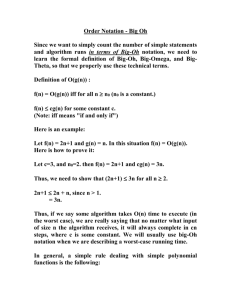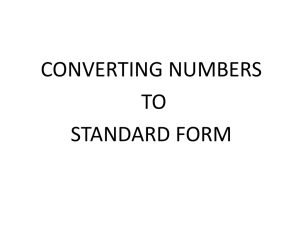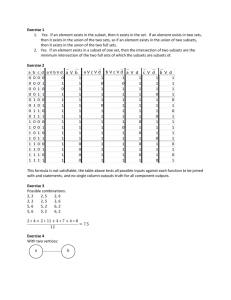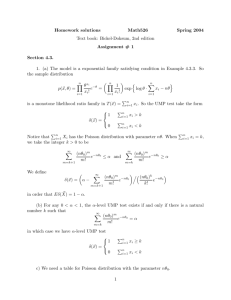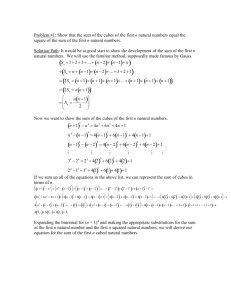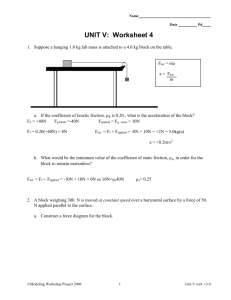Algorithm Analysis
advertisement
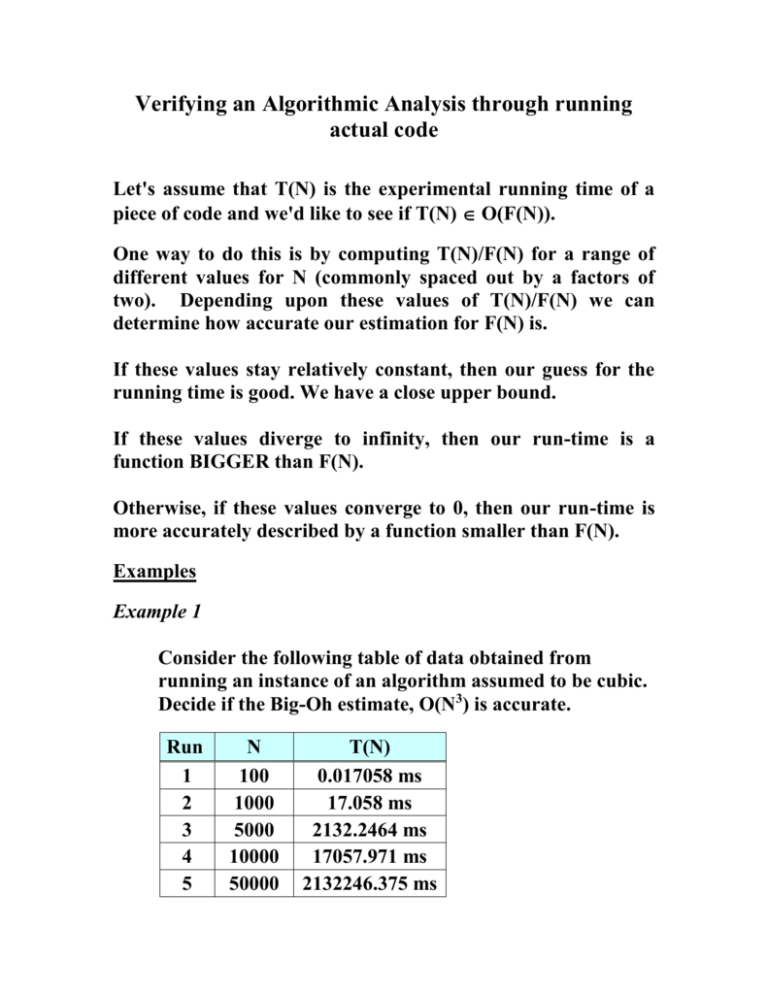
Verifying an Algorithmic Analysis through running actual code Let's assume that T(N) is the experimental running time of a piece of code and we'd like to see if T(N) O(F(N)). One way to do this is by computing T(N)/F(N) for a range of different values for N (commonly spaced out by a factors of two). Depending upon these values of T(N)/F(N) we can determine how accurate our estimation for F(N) is. If these values stay relatively constant, then our guess for the running time is good. We have a close upper bound. If these values diverge to infinity, then our run-time is a function BIGGER than F(N). Otherwise, if these values converge to 0, then our run-time is more accurately described by a function smaller than F(N). Examples Example 1 Consider the following table of data obtained from running an instance of an algorithm assumed to be cubic. Decide if the Big-Oh estimate, O(N3) is accurate. Run 1 2 3 4 5 N 100 1000 5000 10000 50000 T(N) 0.017058 ms 17.058 ms 2132.2464 ms 17057.971 ms 2132246.375 ms T(N)/F(N) = 0.017058/(100*100*100) = 1.0758 10-8 T(N)/F(N) = 17.058/(1000*1000*1000) = 1.0758 10-8 T(N)/F(N) = 2132.2464/(5000*5000*5000) = 1.0757 10-8 T(N)/F(N) = 17057.971/(10000*10000*10000) = 1.0757 10-8 T(N)/F(N) = 2132246.375/(50000*50000*50000) = 1.0757 10-8 The calculated values converge to a positive constant (1.0757 10-8) – so the estimate of O(n3) is a good estimate. Example 2 Consider the following table of data obtained from running an instance of an algorithm assumed to be quadratic. Decide if the Big-Oh estimate, O(N2) is accurate. Run 1 2 3 4 5 N T(N) 100 0.00012 ms 1000 0.03389 ms 10000 10.6478 ms 100000 2970.0177 ms 1000000 938521.971 ms T(N)/F(N) = 0.00012/(100 * 100) = 1.6 10-8 T(N)/F(N) = 0.03389/(1000 * 1000) = 3.389 10-8 T(N)/F(N) = 10.6478/(10000 * 10000) = 1.064 10-7 T(N)/F(N) = 2970.0177/(100000 * 100000) = 2.970 10-7 T(N)/F(N) = 938521.971/(1000000 * 1000000) =9.385 10-7 The values diverge, so O(n2) is an underestimate. Limitations of Big-Oh Notation 1) not useful for small sizes of input sets 2) omission of the constants can be misleading – example 2NlogN and 1000N, even though its growth rate is larger the first function is probably better. Constants also reflect things like memory access and disk access. 3) assumes an infinite amount of memory – not trivial when using large data sets 4) accurate analysis relies on clever observations to optimize the algorithm. Growth Rates of Various Functions The table below illustrates how various functions grow with the size of the input n. Assume that the functions shown in this table are to be executed on a machine which will execute a million instructions per second. A linear function which consists of one million instructions will require one second to execute. This same linear function will require only 410-5 seconds (40 microseconds) if the number of instructions (a function of input size) is 40. Now consider an exponential function. log n 0 n n n log n n2 n3 2n 1 1 0 1 1 2 1 1.4 2 2 4 8 4 2 2 4 8 16 64 16 3 2.8 8 24 64 512 256 4 4 16 64 256 4096 65,536 5 5. 3 6 5.7 32 160 1024 32,768 4.294109 40 212 1600 64000 1.0991012 8 64 384 4096 262,144 1.8441019 ~10 31.6 1000 9966 106 109 NaN =) 6.3 The Growth Rate of Functions (in terms of steps in the algorithm) When the input size is 32 approximately 4.3109 steps will be required (since 232 = 4.29109). Given our system performance this algorithm will require a running time of approximately 71.58 minutes. Now consider the effect of increasing the input size to 40, which will require approximately 1.1x1012 steps (since 240 = 1.09x1012). Given our conditions this function will require about 18325 minutes (12.7 days) to compute. If n is increased to 50 the time required will increase to about 35.7 years. If n increases to 60 the time increases to 36558 years and if n increases to 100 a total of 4x1016 years will be needed! Suppose that an algorithm takes T(N) time to run for a problem of size N – the question becomes – how long will it take to solve a larger problem? As an example, assume that the algorithm is an O(N3 ) algorithm. This implies: T(N) = cN3. If we increase the size of the problem by a factor of 10 we have: T(10N) = c(10N)3. This gives us: T(10N) = 1000cN3 = 1000T(N) (since T(N) = cN3) Therefore, the running time of a cubic algorithm will increase by a factor of 1000 if the size of the problem is increased by a factor of 10. Similarly, increasing the problem size by another factor of 10 (increasing N to 100) will result in another 1000 fold increase in the running time of the algorithm (from 1000 to 1106). T(100N) = c(100N)3 = 1106cN3 = 1106T(N) A similar argument will hold for quadratic and linear algorithms, but a slightly different approach is required for logarithmic algorithms. These are shown below. For a quadratic algorithm, we have T(N) = cN2. This implies: T(10N) = c(10N)2. Expanding produces the form: T(10N) = 100cN2 = 100T(N). Therefore, when the input size increases by a factor of 10 the running time of the quadratic algorithm will increase by a factor of 100. For a linear algorithm, we have T(N) = cN. This implies: T(10N) = c(10N). Expanding produces the form: T(10N) = 10cN = 10T(N). Therefore, when the input size increases by a factor of 10 the running time of the linear algorithm will increase by the same factor of 10. In general, an f-fold increase in input size will yield an f 3-fold increase in the running time of a cubic algorithm, an f 2-fold increase in the running time of a quadratic algorithm, and an f-fold increase in the running time of a linear algorithm. The analysis for the linear, quadratic, cubic (and in general polynomial) algorithms does not work when in the presence of logarithmic terms. When an O(N logN) algorithm experiences a 10-fold increase in input size, the running time increases by a factor which is only slightly larger than 10. For example, increasing the input by a factor of 10 for an O(N logN) algorithm produces: T(10N) = c(10N) log(10N). Expanding this yields: T(10N) = 10cN log(10N) = 10cN log10 + 10cN logN = 10T(N) + cN (where c = 10clog10). As N gets very large, the ratio T(10N)/T(N) gets closer to 10 (since cN/T(N) (10 log10)/logN gets smaller and smaller as N increases. The above analysis implies, for a logarithmic algorithm, if the algorithm is competitive with a linear algorithm for a sufficiently large value of N, it will remain so for slightly larger N.
